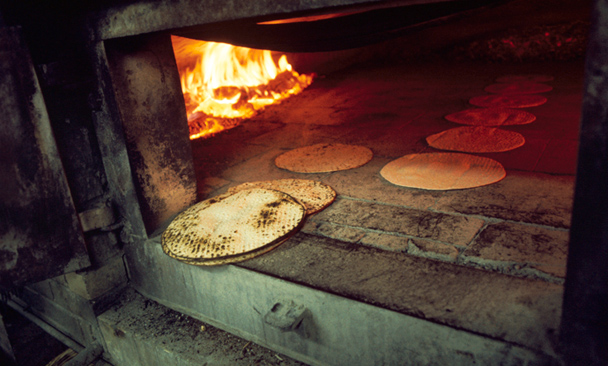Matzoh and Communion wafers might seem like apples and oranges. Their sizes are different. Their uses are different. And what they symbolize is very different. Yet neither form of bread is immune to food fads and shifting trends. You might even wonder, Is nothing sacred?
Matzoh is eaten year-round but is most significant at Passover. Unleavened to commemorate the Jews’ exodus from Egypt—departing in such haste that there wasn’t time for the bread to rise—matzoh is an integral part of the Passover seder. When labeled Kosher for Passover, matzoh is made with nothing but flour and water, no salt or fat; traditionally, matzoh must be made in 18 minutes, start to finish, to ensure no fermentation can begin in the flour.
Communion wafers—Christian altar bread—evoke the Last Supper, at which Jesus said that bread symbolized his body (and wine his blood). And like matzoh, they are nothing more than flour and water—in this case, baked into thin crisps—until they are consecrated to take on their greater meaning in some Christian services.
It’s been two thirds of a lifetime since I last tasted a Communion wafer, but I remember it had no taste because I was taught not to chew the host, just to let it dissolve on my tongue while thinking of God (not breakfast after Mass). And I had not had matzoh in half a lifetime until I bought a box the other day to see if it was as flavor-free as I recalled from my days cooking in a Manhattan café that put matzoh brei—a popular dish of matzoh and eggs—on the menu during Passover. The taste turned out to be very familiar, though: The unsalted kind from Streit’s is indistinguishable to me from Carr’s water crackers.
The matzoh label boasts all the current nutritional buzzwords, too: Fat-free. No saturated fat. No trans fat. No cholesterol. No sodium. If I had wanted, I could also have bought them gluten-free.
Marketing to today’s health concerns cum food fixations is only one way matzohs have morphed. With nonkosher matzoh, producers can take flavor liberties, and Streit’s was the first: Its Moonstrips, introduced in the 1940s, paved the way and continue to be sold today in onion-poppy flavor. Streit’s now makes organic, whole wheat, and spelt matzoh as well as a version with salt and pepper. In the last five years, it has marketed a Mediterranean kind, baked with sun-dried tomatoes, basil, and olive oil.
Matzoh is even getting the artisanal treatment. Three years ago, Naga Bakehouse in Vermont started crafting Vermatzah, using a blend of organic wheat and spelt. These are hand-shaped into rounds, rather than the commercial makers’ traditional 7-inch squares, and baked in a wood-fired oven. The company calls its bread “eco-kosher”—no wonder the Web site Hipster Jew is so taken with it.
Proving that no food is too esoteric to merit a cooking class, the Institute of Culinary Education in Manhattan teaches how to bake matzoh, in white or whole wheat and flavored with various seeds, including mustard, nigella, flax, or fennel.
And though chocolate-covered matzohs are nothing new, matzoh is not untouched by the high-end chocolate craze. Coco Délice sells the bread coated in Belgian dark stuff, complete with the requisite cocoa nibs and salt. Ambacht Brewery in Oregon even makes a beer with matzoh, Matzobrau, which is sold after Passover (beer, which is made with fermented grains, is not kosher for Passover).
Communion wafers, by contrast, are much less voguish. Any flavored wafers found online—barbecue, chocolate, sour cream—are spoofs, because the whole point is an absence of taste. There is apparently a market for whole wheat wafers, though it may take a leap of faith to ascribe health benefits to a bread so tiny.
One trend that’s evolving is gluten-free, which caters to communicants with celiac disease or gluten sensitivities. Glutenfreehosts.com sells Zero Gluten Hosts, made from potato starch, which the manufacturer bills as acceptable to all denominations but the Catholic Church. Another product, Gluten Free Hosts—which the maker says Catholics can use—contains 20 parts gluten per million, which qualifies under FDA guidelines for gluten-free labeling. Some churches allow parishioners with celiac disease to bring their own gluten-free wafers to be consecrated; other churches provide them.



 Pinterest
Pinterest


